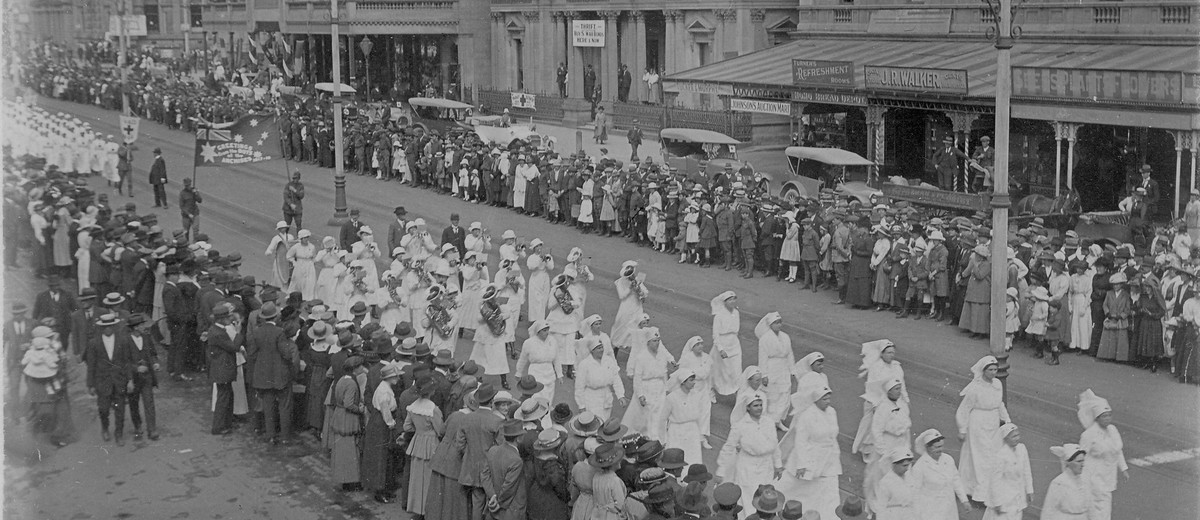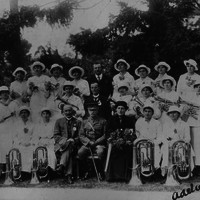In May 1915, the South Australian Cheer-up Society established its Burra Branch, to grant local departing soldiers an adequate and social send-off to the Great War. While this branch, in and of itself, greatly influenced South Australian history, one of their more significant enterprises was the foundation of the Burra Cheer-up Ladies’ Band (BCLB).
Formation of the BCLB
The BCLB was formed in 1916 as a replacement for the Burra Coronation Band (BCB), which had dissolved that same year due to approximately sixteen of its members enlisting. According to newspapers, on Tuesday 7 November 1916, the Burra Cheer-up Society met to formally establish the band, to ‘render assistance at all [of Burra’s] patriotic gatherings’, including welcoming returning soldiers at the local train station. Resident music teacher, Mr James ‘Jim’ Bentley - cousin to Miss Beatrice ‘Trix’ Pearce, Hon. Secretary of the Burra Cheer-up Society and band organiser – was recruited as the ensemble’s conductor, a gargantuan task considering many of the women could not read music or were unfamiliar with the instruments they intended to play. While the list of members present at the band’s formation is unknown, according to Eric Fuss of the Burra History Group, a Burra Record newspaper for March 1917 states the band consisted of:
Beatrice ‘Trix’ Pearce
Nellie Pearce
Annie Pearce
Hilda Hunt
Edith ‘Edie’ Harris
Delcie McWaters
Lily Riggs
Doreen Pressick
Myrtle Isaacs
Lydia Burns
Ethel James
Olive Hopgood
Gladys Lawn
Another photo from the Burra History Group, dated as 1914 - even though newspaper records and an article by Trix Pearce’s nephew infer the BCLB and Burra Cheer-up Society did not exist at that stage - details a much larger group:
Practice and Performance
The band’s first rehearsal was on 9 November 1916, having been given permission by the Town Council to use the BCB’s instruments. However, the BCLB’s beginning proved troublesome, as ‘the majority of the instruments, refused to do what was required of them, and [the band] had to retire beaten’ until new instruments could be purchased through subscriptions and donations; funds repeatedly asked for through the Burra Record. According to the Burra Cheer-up Society’s Annual Report, by June 1917 the BCLB possessed new equipment in the form of seven cornets, four tenor horns, two baritones, one euphonium, twelve music stands, and four acetylene gas lamps.
The BCLB’s first public appearance was on 19 February 1917, at the Exhibition Concert Party, after which point they rapidly gained renown as a proficient musical group. While their primary role was welcoming returning soldiers, a task they completed over 175 times, the band received ‘invitations to play at functions in Adelaide and in country towns… more often than could be accommodated’. As such the band played at many events of varying importance throughout 1917, 1918 and 1919, including Anzac Day celebrations, Violet Days, local shows, Navy Day, Red Cross events, and Australia Day festivals.
A Royal Reception
The intention had been to disband the group and the Burra Cheer-up Society branch when the last Burra soldier came home; Walter Lee on the 15 March 1920. However, in July 1920 the BCLB was asked to participate in the Royal Visit and Reception of the Prince of Wales to South Australia; their penultimate musical performance before officially dissolving at a social evening at St Mary’s Parish Hall in early August 1920. The royal reception took place at the Adelaide Town Hall, where ‘a platform, prettily decorated with wattle foliage, had been erected’ for them to play on, alternating with the Glenelg Band who had also been asked to play at the event. The festivities progressed well until:
‘…just as the Prince was stepping from his car, an overzealous camera fiend mounted on the frail protection overhead and a crowd… rushed the platform (made to carry 30 people) and the consequence was that the whole structure collapsed with a crash just as the last note of “God Bless the Prince of Wales” was reached.’
Despite this disaster, none of the girls nor their instruments appeared to be seriously injured and they ‘pulled themselves together, quickly enough in fact to witness the civic welcome and the presentation of the address’. Later, having been so pleased with their work and commitment, the Prince requested that Trix Pearce be presented to him. After asking certain questions about the group’s history he and Pearce shook hands and then he congratulated her on the band’s splendid accomplishment. Thereafter the band's members dispersed, though ‘there could hardly have been a more brilliant finale’. Considering that, like the majority of the people, Conductor Bentley thought the girls were joking when they first proposed the band to him, it is testament to the ensemble’s persistence and talent ‘that their last public appearance would be made so memorable with words of approbation, personally spoken by His Royal Highness the Prince of Wales’.
ABC News, ‘Burra Cheer-Up Ladies Band: Keeping the music alive during war’s dark days’, https://www.abc.net.au/news/2014-04-25/burra-cheer-up-ladies-band/5404654?pfmredir=sm accessed 31 January 2019.
Burra cheer-up society, Second Annual Report (Burra, 1917), pp5-6.
Burra Record, ‘Burra Band’, 29 November 1916, p4.
Burra Record, ‘Burra Cheer-Up Society’, 15 November 1916, p2.
Burra Record, ‘Burra Cheer-up Society’, 6 December 1916, p3.
Burra Record, ‘The Prince’s Visit’, 21 July 1920, p3.
Daily Herald, ‘A Ladies’ Band’, 9 November 1916, p4.
Dearlove, Tom, ‘The Burra Cheer-up Ladies Band – A Memoir’, The South Australian Genealogist, August 2002, p17.
Fuss, Eric, ‘The Cheer-Up Society in Adelaide and Burra: 1914-1920’ (Burra: Burra History Group, 2015), pp24-41.




Add your comment